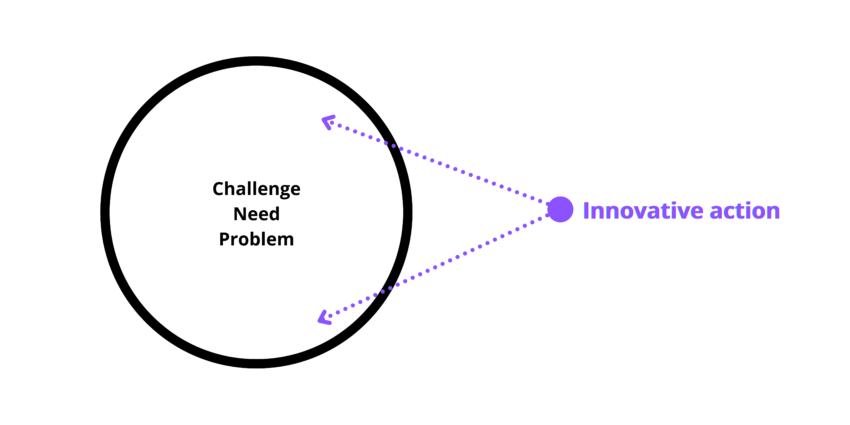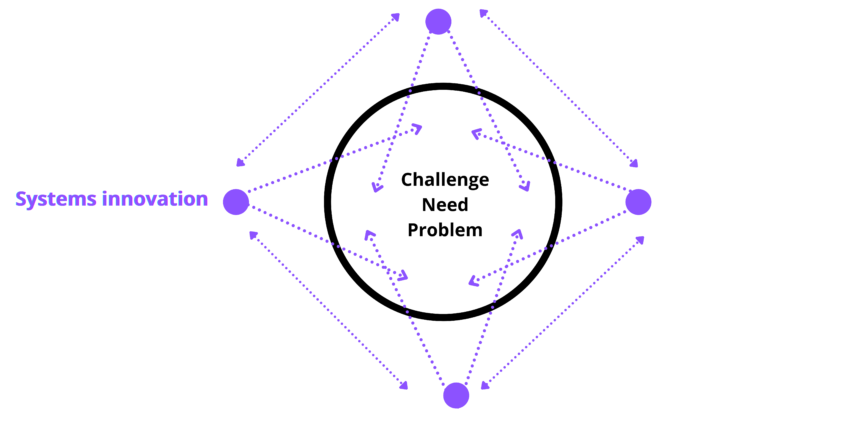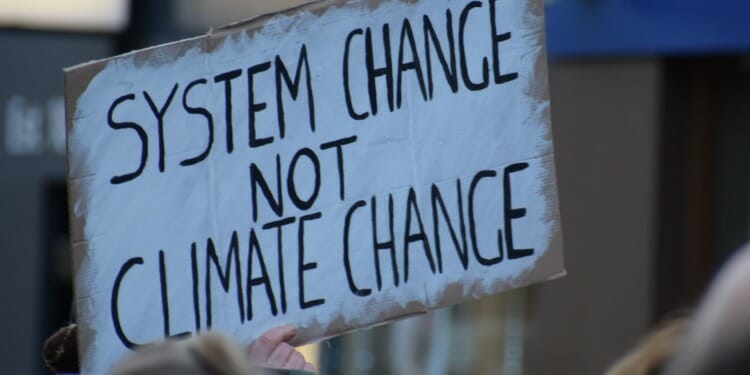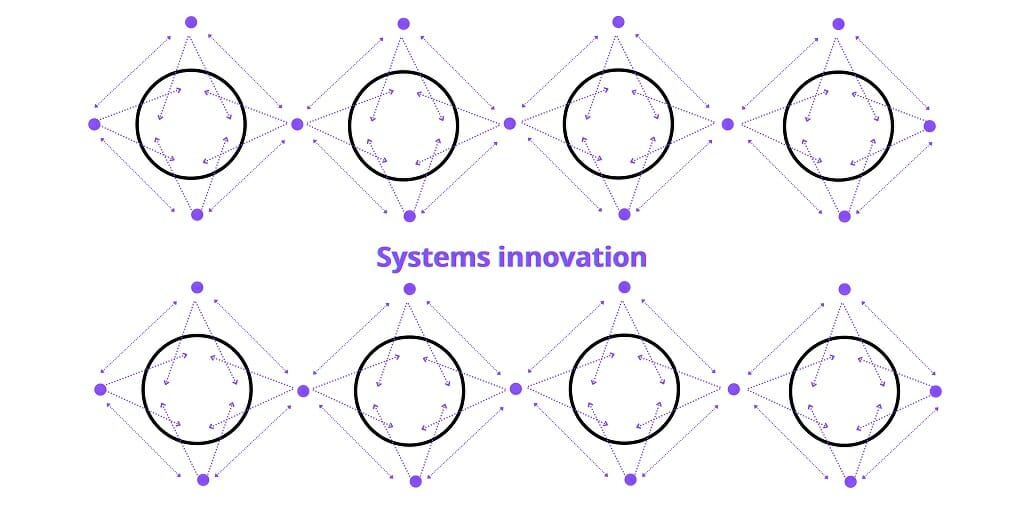Innovation catalyses change. However, it is not enough to overcome global challenges and transform the systems that we operate within. Limiting our activity just to one-off innovative actions will not get us closer to a carbon-neutral and more just society.
How does a one-off, innovative action look like in practice? Imagine a recently built detached house with a pitched roof covered with tiles and solar panels. On the same roof, there is also a chimney and black smoke coming out of it.
Solar panels are a symbol of innovation. However, they are just an extra if the heating system is based on fossil fuels. This is a perfect example of dealing with energy transition without an integrated and systemic approach.
For this reason, we need to learn and apply systems thinking daily and experiment with systems innovation. They are a win-win combo that guides us through complexity and different contexts while equipping us with a 360 degrees perspective to tackle challenges. This way, we avoid unintended consequences and unforeseen issues.
To Change The System, We Need To Understand Its Logic
Thinking in systems is a competency that should be acquired and developed on both personal and institutional levels. Systems thinking allows us to realize that there are multiple dimensions in which everything is interconnected, circular, dynamic, and adaptive.
Applying systems thinking in a transformative process requires creating an open, just and inclusive environment ensuring that no one has been left behind. This is a reason why we need to empower decision-makers, actors of change, communities, and vulnerable groups to be part of a new, inclusive solidarity movement that will co-own transformative processes towards climate neutrality and a prosperous future for all. Multilevel cooperation is crucial to strengthen the complementarity, impact, and connectivity between different stakeholders and to help combat imbalances.
Space For Experimentation
Connecting people with a multitude of perspectives around shared challenges can unlock new opportunities for social innovation and co-designing unexpected solutions. Discovering new models of cooperation and co-hosting transformative processes is crucial to the acceleration of systemic change.
From an infrastructural and technological perspective, it is evident what should be done to achieve a successful transition towards a climate-friendly future. However, we need to explore, experiment, and test cooperation models which can make this happen.
For this reason, we do not need one-off innovative actions that are separate or overlapping. There is an increasing demand for interconnected interventions that create a supporting ecosystem that fosters innovation and collaboration to tackle major challenges and accelerate change.
An interesting example of how to apply this approach in practice comes from the London borough of Camden where the local Council launched the Camden Renewal Commission in 2020.
The Commission aims at developing practical solutions to help create a fair, sustainable society and address the inequalities through the engagement and work of an interdisciplinary group of representatives of the local community and process facilitators. The first outcomes of the project are four mission-oriented goals designed to channel the actions of public, private, and civic actors to achieve them in 5-10 years.
Furthermore, this type of experimentation and use of testbeds plays a crucial role in transforming and reimagining systems because their long-term goal is not to deliver a novel action in a new setting, but to scale up and have an impact.
RELATED ARTICLES: 6 Ways to Remove Carbon Pollution From the Sky | The Road To Net Zero: A Guide To The Carbon Offset Ecosystem | Carbon Offsetting as a Tool to Reduce Emissions: A Last Resort? | How to Make Agriculture Carbon-neutral: Lessons from Denmark | Direct Air Capture: Resource Considerations and Costs for Carbon Removal
One-off innovation vs. systemic innovation
Two graphics below highlight the difference between a one-off innovation and a systems innovation:


Innovative, one-off actions tend to focus only on one angle of a challenge, a need, or a problem. They are about launching a new project, service, or product in addition to the existing system.
What actually happens when we use one-off innovative actions? Imagine solving the problem of traffic congestion in a city using this approach. An easy solution would be building a new road or widening the existing ones. However, it would bring only short-term relief. Overall, the traffic would increase, resulting in amplifying, not solving the problem.
On the other hand, if we aim to solve this challenge holistically and with systemic innovation, this process should start with extensive mapping, contextualization of this problem, and pointing out all the factors that influence it. Identifying all the elements helps to understand the complexity of seemingly simple challenges, showing the variety of actions in different, at first glance unconnected, fields that need to be taken to co-design deep and long-term solutions.
Tackling urban traffic congestion cannot be limited just to widening and increasing new road infrastructure. However, applying this solution is still popular and demanded. When analyzing drivers and factors influencing traffic congestion, we realize how interdisciplinary it is. Furthermore, a mapping reflects the current state of urban management, policies, economy, beliefs, behaviors, and attitudes that affect the main challenge: traffic congestion and urban mobility.
Thus, to cover it holistically, we need to focus on mobility as a service, experience, and policy, as well as its links to other, at first glance unrelated policies: taxation and housing This perspective triggers a novel approach towards this challenge.
First, we start realizing that people do not want to own cars to commute. They just want to have an efficient, comfortable, and on-demand mobility system. Simply, if our cities are designed for cars, there will be more cars. On the other hand, if we apply a human-centered perspective, there will be a diverse range of urban mobility options reflecting people’s needs and expected services.
Furthermore, transforming and greening mobility within a city catalyzes changes in other relevant areas of an urban system increasing quality of life and happiness. Therefore, it is not about the way we commute and move around, but how we design urban spaces, promote healthy and carbon-neutral habits, as well as how we transform collected data into services and policies. A systemic perspective helps to amplify the impact of our actions and heals the system in which we operate.
After completing this mapping, we are aware that a single innovative action will not address all the economic, societal, environmental, technological, and gap areas. We need to find cross-cutting areas to co-design actions with local stakeholders to leverage change and empower their agents. It provides an excellent opportunity to start cooperating in a more inclusive and open way, leaving siloed structures behind and creating a network of initiatives that reinforce themselves.
Ending Up In A Green Silo
Systems innovation plays an essential role in tackling main crises on a global and local scale, as well as in building the resilience of the places we live in, their communities, and economies. We need to become more collaborative to connect our actions to overcome the biggest challenge of our times – climate change.
It is evident that without integrated and systemic innovations we will not be able to transition and meet the objectives of the Paris Agreement and European Green Deal. It will result in being trapped in a green silo if we do not build a critical mass of interdisciplinary actions.
Why? Imagine placing giant solar panels covering Earth, but without changing our operating paradigms and behavior. While we would rely on energy from renewable sources, we would continue to consume beyond our means and destroy natural resources.
That is why we need integrated and holistic approaches towards innovation and long-term planning to establish a new environmental, economic, societal and political contract based on respect, responsibility and prosperity for all.
This vision can be achieved by shifting existing paradigms and breaking down silos when taking innovative actions. Currently, during discussions about climate change, we focus mostly on cutting green gas emissions. However, we cannot be obsessed exclusively with it. Simultaneously, we need to cover other challenges including overconsumption, climate justice, biodiversity loss, education, health, and poverty. Transformations embedding interdisciplinary and integrated approaches are the only way to avoid building green silos.
Systems transformations are not easy to develop due to the complexity of the systems, resistance to change of some of their actors, and siloed structures. We can overcome these obstacles only by building a new global and inclusive movement that connects and does not exclude anyone.
Cop Or Not To Cop?
Creating an empathic, solidary and cross-dimensional movement is especially relevant after the COP 26 in Glasgow. It was a moment when everyone was in the room of a ‘climate one-stop shop’, both physically and online. It gave an opportunity for connecting, setting up joint agenda, interdisciplinary action plans, and integrating all involved actors representing different contexts and backgrounds.
According to the Twelve Leverage Points scale model created by Donella Meadows, the less impactful action to change the system is to amend metrics. On the other hand, the most effective way is to shift mindsets, paradigms, and mental models.
It is up to us how we want to leverage the current system and unlock transformations. We can do it with numbers and declarations about reaching climate neutrality by a certain year or can change our relationship with Earth, its resources, and all inhabitants. The second option requires setting up a new global contract aiming at establishing regenerative conditions for natural, societal, economic, and political systems.
Depending on the actions we take and the approaches we apply, there will be a light at the end of a green tunnel or not.
Editor’s Note: The opinions expressed here by Impakter.com columnists are their own, not those of Impakter.com












